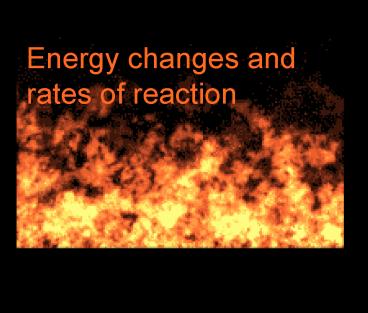Energy changes and - PowerPoint PPT Presentation
1 / 18
Title:
Energy changes and
Description:
There are far more exothermic reactions than endothermic ones. When we carry out an exothermic reaction in a test tube, the test tube gets hot. ... – PowerPoint PPT presentation
Number of Views:49
Avg rating:3.0/5.0
Title: Energy changes and
1
Energy changes and rates of reaction
2
Combustion is a process in which a
self-sustaining chemical reaction occurs at
temperatures above those of the surroundings.
More simply, combustion is burning. Explosions
are also forms of combustion.
3
Some common combustion reactions are the burning
of coke (carbon), petrol (for example, octane)
and natural gas (methane). The reactants are
oxygen from the air and the greyish-black solid
(coke), the colourless liquid (octane) and the
colourless gas (methane). Each of these burns
with a bluish fl ame to form colourless
carbon dioxide gas and colourless water
vapour. Chemical reactions have occurred here
(rather than just physical changes) because
4
(No Transcript)
5
The amounts of heat released in the above
reactions are 393 kJ/mol for coke, 890 kJ/mol for
methane and 5460 kJ/mol for octane. All
combustion reactions liberate large amounts of
heat. They are what we call exothermic reaction
6
EXOTHERMIC AND ENDOTHERMIC REACTIONS
discuss signs etc
7
Examples of endothermic chemical reactions are
There are far more exothermic reactions than
endothermic ones. When we carry out an exothermic
reaction in a test tube, the test tube gets
hot. This is because as the reaction occurs there
is a decrease in chemical energy and the lost
chemical energy is released as heat, which warms
up the test tube and its contents. When an
endothermic reaction occurs, the test tube gets
cold. This is because the reaction as it occurs
needs to take in heat (to convert to
chemical energy). The only place the reaction can
get this heat is from the test tube and
its contents and so they get cold. Unfortunately
the heat released or absorbed during a reaction
depends to some extent on the conditions under
which the reaction is carried out, in particular
upon whether it is performed at constant volume
(in a closed vessel) or at constant pressure (in
a container open to the atmosphere). This is
particularly true for reactions involving gases.
When we compare heats from different reactions,
we should do so using constant conditions. Hence
we introduce a new term called enthalpy.
8
ENTHALPY
Enthalpy is a measure of the total energy
possessed by a substance or group of substances.
We can think of enthalpy as being mainly the
chemical energy stored in a substance.
Unfortunately we cannot measure this total energy
or enthalpy of a substance all we can do is
measure changes in it.
Since most experiments we shall be dealing with
occur at constant pressure (open to the
atmosphere), the heat absorbed or released will
be a direct measure of ?H. By change in
enthalpy we mean the increase in enthalpy in
going from reactants to products ?H enthalpy
of products enthalpy of reactants
9
(No Transcript)
10
NOT GOOD.....in a small way.......I will explain
11
activated
an exothermic change
Ea
Enthalpy H
reactants
heat released
products
initial enthalpy
Reaction time (s)
12
activated state
Enthalpy H
Ea
products
Heat absorbed
reactants
initial enthalpy
An endothermic change
13
(No Transcript)
14
http//www.chem.ufl.edu/itl/2045/matter/FG05_017.
GIF
15
(No Transcript)
16
17
(No Transcript)
18
Analyse This!































